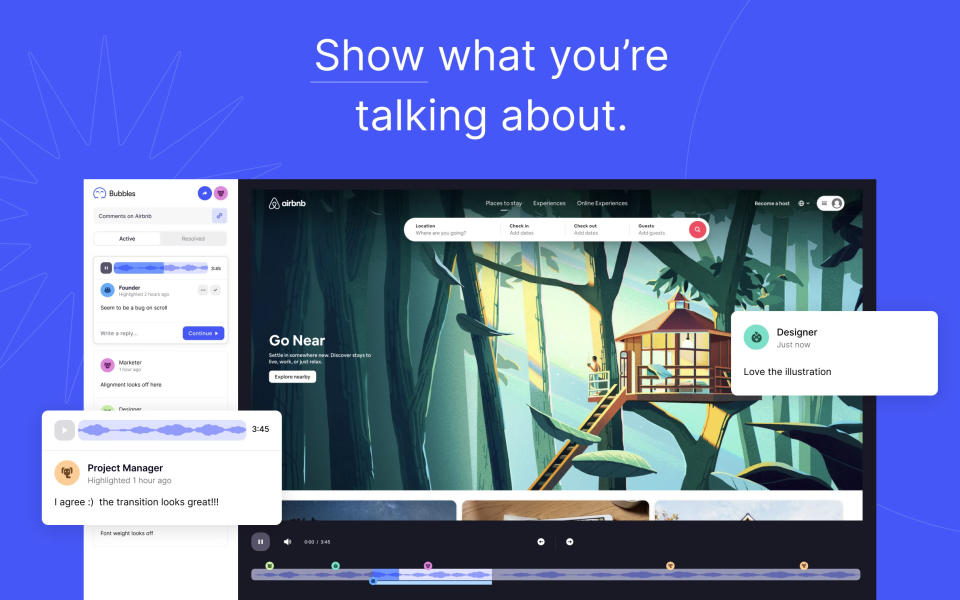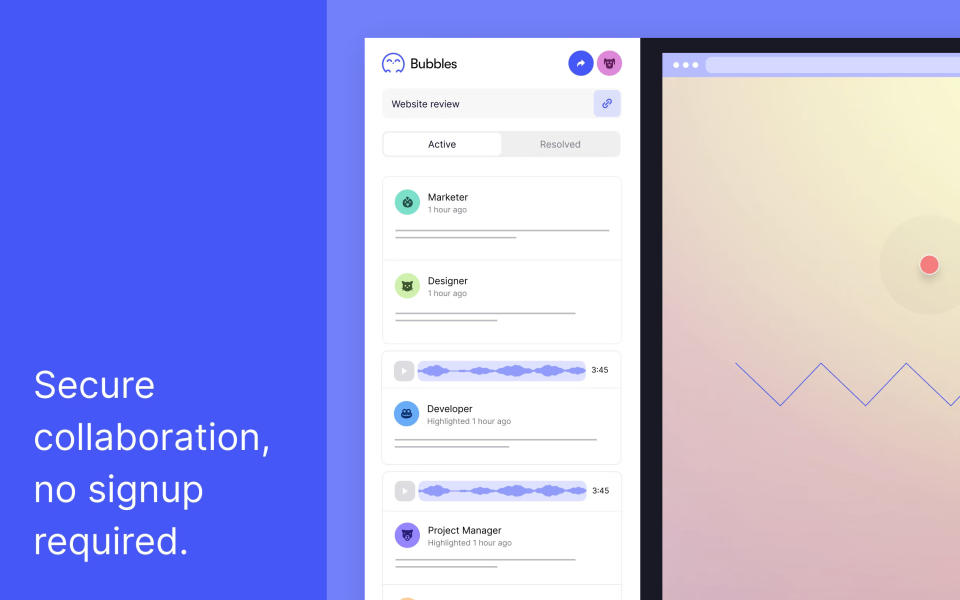Bubbles aims to supercharge chats with async video messaging
Bubbles, a startup that pitches its platform as the "anti-Zoom" for video messaging, today announced that it closed an $8.5 million funding round led by Khosla Ventures, Craft Ventures, Streamlined Ventures, 468 Ventures and Bain Capital. Co-founder and CEO Tom Medema said the money will be used to further develop Bubbles' platform while ramping up the company's customer acquisition efforts.
Bubbles adds threaded video, audio and text comments to workers' desktops -- an idea that Medema said came to him when he was the CTO at Bloomon, a flower delivery service in the Netherlands. There, Medema managed a distributed team that relied on what's become the typical software stack for workplace collaboration: Slack, Zoom and Google Docs.
"As the team grew, and collaboration became ever more crucial, I quickly realized this collection of tools fell short -- and our team paid the price. It was a maddening game of calendar tetris, constant notifications, and continuous undoing of miscommunications," Medema told TechCrunch via email. "What I realized was that our so-called productivity tools were actually throttling our productivity. We are 'always on,' but failing to accomplish real work. Searching for a solution, hacking my way into our outdated systems and processes, I came up with the vision for Bubbles."
Medema began work on Bubbles in 2019, but he argues that the tool has become even more relevant with the normalization of work-from-home setups. Medema, a pessimist when it comes to remote work -- or, more accurately, typical remote work software -- points to a 2021 study of Microsoft and LinkedIn employees that found that employees are burned out and "digitally exhausted."

Image Credits: Bubbles
"Our mission is to return joy to work: to get back to creativity and productivity, to foster deep work, and to mitigate burnout by moving away from hyper-responsiveness and real-time communication towards greater asynchronous communication," Medema continued. "Async platforms are at the top of their list as it frees up employees’ time to do deep work, and mitigates the digital burnout that occurs by being overwhelmed with meetings and notifications all day."
With Bubbles, users can asynchronously send and receive messages -- video or otherwise -- with threading, which Medema claims allows for more thoughtful feedback. Historically, the challenge with asynchronous video tools has been user buy-in. It's easier to fire off a quick Slack message than record and edit a video, after all. But Bubbles attempts to make the process less unappealing by streamlining many aspects of it, dispensing with passwords, onboarding steps and even usernames.
Users start a Bubbles conversation from a web browser, capturing their perspective through video, audio or a screen recording and inviting collaborators. This begins a threaded conversation where participants can comment at and add reactions to specific time codes.
Future plans include improved discovery, specifically semantic search and topic modeling, which Medema says will allow Bubbles users to "intuitively search across conversations." Beyond this, Medema says that Bubbles will introduce transcription and summarization capabilities, automatically highlighting important sections in videos and suggesting action items.
"'Quick questions' on Slack, inboxes full of emails, and a never-ending stream of notifications hold us back from achieving the precious state of deep work and flow," Medema said. "Bubbles is an async-first tool, designed to work outside of the outdated construct of the meeting -- allowing users to collaborate on work at every individual’s optimal time."
Bubbles isn't the first to attempt the asynchronous messaging paradigm. Others include Weet, Threads and Claap. Slack recently dipped a toe with Slack Clips, which lets users embed audio, video and screen recordings within channels and direct messages.
Medema claims that Bubbles recently surpassed 20,000 monthly active users -- a healthy number, to be sure -- but the trick will be commercializing it. Bubbles is currently free. Monetization plans include a team tier with folders and granular access control.

Image Credits: Bubbles
"The past two years have taught leaders not only that work was more than capable of being completed from home, but also highlighted that employees work better with flexibility and control of their own schedules. However, by hyper-accelerating our conversion to remote work, it also exposed the deep flaws in our existing remote work tools, which were not really designed to be used in a remote world," Medema said. "Bubbles’ async nature [keeps] a record of conversations as they happen. This also helps partially overcome the knowledge loss that occurs due to employee turnover, which is a key challenge in today’s work environment."
Bubbles has eight employees. The company plans to double the size of the team by the end of the year.

 Yahoo Finance
Yahoo Finance 